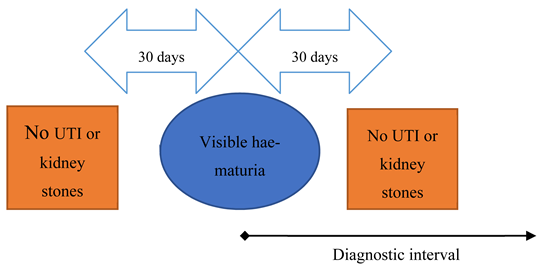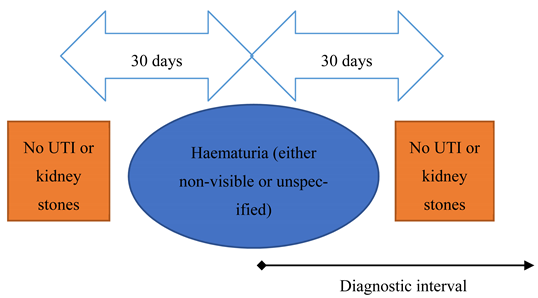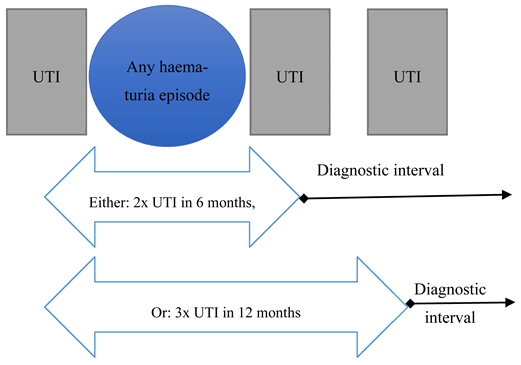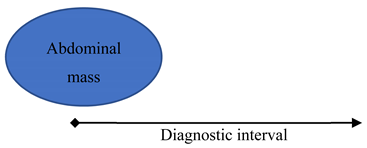Prolonged Diagnostic Intervals as Marker of Missed Diagnostic Opportunities in Bladder and Kidney Cancer Patients with Alarm Features: A Longitudinal Linked Data Study
Abstract
:Simple Summary
Abstract
1. Background
2. Method
2.1. Data
2.2. Defining Fast-Track Scenarios
2.3. Diagnostic Timeliness
2.4. Analysis
3. Results
3.1. Clinical Features
3.2. Patients Who Met Fast-Track Referral Criteria
3.3. Factors Associated with Non-Timely Diagnosis
4. Discussion
4.1. Strengths and Limitations
4.2. Implications
5. Conclusions
Supplementary Materials
Author Contributions
Funding
Institutional Review Board Statement
Informed Consent Statement
Data Availability Statement
Conflicts of Interest
References
- Wolfe, A. Institute of Medicine Report: Crossing the Quality Chasm: A New Health Care System for the 21st Century. Policy Politics Nurs. Pract. 2001, 2, 233–235. [Google Scholar] [CrossRef]
- Institute of Medicine. Improving Diagnosis in Health Care. National Academies of Sciences, Engineering, and Medicine. Available online: https://www.nap.edu/catalog/21794/improving-diagnosis-in-health-care (accessed on 1 December 2020).
- Hamilton, W.; Walter, F.M.; Rubin, G.; Neal, R.D. Improving early diagnosis of symptomatic cancer. Nat. Rev. Clin. Oncol. 2016, 13, 740–749. [Google Scholar] [CrossRef] [PubMed]
- Neal, R.; Tharmanathan, P.; France, B.; Din, N.; Cotton, S.; Fallon-Ferguson, J.; Hamilton, W.; Hendry, A.; Hendry, M.; Lewis, R. Is increased time to diagnosis and treatment in symptomatic cancer associated with poorer outomes? Sys-tematic review. Br. J. Cancer 2015, 112, S92–S107. [Google Scholar] [CrossRef] [PubMed] [Green Version]
- Cancer Research UK. Statistics by Cancer Type. Cancer Research UK. Available online: https://www.cancerresearchuk.org/health-professional/cancer-statistics/statistics-by-cancer-type (accessed on 1 December 2020).
- Koo, M.M.; Hamilton, W.; Walter, F.M.; Rubin, G.P.; Lyratzopoulos, G. Symptom signatures and diagnostic timeli-ness in cancer patients: A review of current evidence. Neoplasia 2018, 20, 165–174. [Google Scholar] [CrossRef] [PubMed]
- National Institute for Clinical Excellence. Improving Outcomes for Urological Cancers, National Institute for Clinical Excellence, London. 2002. Available online: https://www.nice.org.uk/guidance/csg2/resources/improving-outcomes-in-urological-cancers-pdf-773372413 (accessed on 1 December 2020).
- Zhou, Y.; Van Melle, M.; Singh, H.; Hamilton, W.; Lyratzopoulos, G.; Walter, F.M. Quality of the diagnostic process in patients presenting with symptoms suggestive of bladder or kidney cancer: A systematic review. BMJ Open 2019, 9, e029143. [Google Scholar] [CrossRef]
- Arhi, C.S.; Burns, E.M.; Bottle, A.; Bouras, G.; Aylin, P.; Ziprin, P.; Darzi, A. Delays in referral from primary care worsen survival for patients with colorectal cancer: A retrospective cohort study. Br. J. Gen. Prac. 2020, 70, e463–e471. [Google Scholar] [CrossRef]
- Zhou, Y.; Funston, G.; Lyratzopoulos, G.; Walter, F.M. Improving the timely detection of bladder and kidney cancer in primary care. Adv. Ther. 2019, 36, 1778–1785. [Google Scholar] [CrossRef] [Green Version]
- National Institute for Clinical Excellence. Nice Guidelines [ng12]: Suspected Cancer: Recognition and Referral. Available online: http://www.nice.org.uk/guidance/NG12/ (accessed on 1 December 2020).
- Zhou, Y.; Mendonca, S.C.; Abel, G.A.; Hamilton, W.; Walter, F.M.; Johnson, S.; Shelton, J.; Elliss-Brookes, L.; McPhail, S.; Lyatzopoulos, G. Variation in ‘fast-track’ referrals for suspected cancer by patient characteristic and cancer diagnosis: Evidence from 670 000 patients with cancers of 35 different sites. Br. J. Cancer 2017, 118, 24–31. [Google Scholar] [CrossRef] [Green Version]
- Abel, G.; Shelton, J.; Johnson, S.; Elliss-Brookes, L.; Lyratzopoulos, G. Cancer-specific variation in emergency presentation by sex, age and deprivation across 27 common and rarer cancers. Br. J. Cancer 2015, 112, S129–S136. [Google Scholar] [CrossRef] [Green Version]
- Choi, D.T.; Davila, J.A.; Sansgiry, S.; David, E.; Singh, H.; El-Serag, H.B.; Sada, Y.H. Factors associated with delay of diagnosis of hepatocellular carcinoma in patients with cirrhosis. Clin. Gastroenterol. Hepatol. 2020. [Google Scholar] [CrossRef]
- Singh, H.; Hirani, K.; Kadiyala, H.; Rudomiotov, O.; Davis, T.; Khan, M.M.; Wahls, T.L. Characteristics and Predictors of Missed Opportunities in Lung Cancer Diagnosis: An Electronic Health Record–Based Study. J. Clin. Oncol. 2010, 28, 3307–3315. [Google Scholar] [CrossRef] [PubMed] [Green Version]
- Zhou, Y.; Abel, G.; Hamilton, W.; Singh, H.; Walter, F.M.; Lyratzopoulos, G. Imaging activity possibly signalling missed diagnostic opportunities in bladder and kidney cancer: A longitudinal data-linkage study using primary care electronic health records. Cancer Epidemiol. 2020, 66, 101703. [Google Scholar] [CrossRef] [PubMed]
- Ark, J.T.; Alvarez, J.R.; Koyama, T.; Bassett, J.C.; Blot, W.J.; Mumma, M.T.; Resnick, M.J.; You, C.; Penson, D.F.; Barocas, D.A. Variation in the Diagnostic Evaluation among Persons with Hematuria: Influence of Gender, Race and Risk Factors for Bladder Cancer. J. Urol. 2017, 198, 1033–1038. [Google Scholar] [CrossRef] [PubMed]
- European Association of Urology. Guideline on Urological Infections. Available online: https://uroweb.org/guideline/urological-infections/ (accessed on 1 December 2020).
- Hollenbeck, B.K.; Dunn, R.L.; Ye, Z.; Hollingsworth, J.M.; Skolarus, T.A.; Kim, S.P.; Montie, J.E.; Lee, C.T.; Wood, D.P.; Miller, D.C. Delays in diagnosis and bladder cancer mortality. Cancer 2010, 116, 5235–5242. [Google Scholar] [CrossRef] [Green Version]
- Richards, M.A.; Westcombe, A.M.; Love, S.B.; Littlejohns, P.; Ramirez, A.J. Influence of delay on survival in patients with breast cancer: A systematic review. Lancet 1999, 353, 1119–1126. [Google Scholar] [CrossRef]
- Chappidi, M.R.; Kates, M.; Tosoian, J.J.; Johnson, M.H.; Hahn, N.M.; Bivalacqua, T.J.; Pierorazio, P.M. Evaluation of gender-based disparities in time from initial haematuria presentation to upper tract urothelial carcinoma diagnosis: Analysis of a nationwide insurance claims database. BJU Int. 2017, 120, 377–386. [Google Scholar] [CrossRef] [Green Version]
- Cohn, J.A.; Vekhter, B.; Ms, C.L.; Steinberg, G.D.; Large, M.C. Sex disparities in diagnosis of bladder cancer after initial presentation with hematuria: A nationwide claims-based investigation. Cancer 2014, 120, 555–561. [Google Scholar] [CrossRef]
- Singh, H.; Bradford, A.; Goeschel, C. Operational measurement of diagnostic safety: State of the science. Diagnosis 2020, 1. [Google Scholar] [CrossRef]
- Price, S.; Stapley, S.A.; Shephard, E.; Barraclough, K.; Hamilton, W.T. Is omission of free text records a possible source of data loss and bias in Clinical Practice Research Datalink studies? A case–control study. BMJ Open 2016, 6, e011664. [Google Scholar] [CrossRef] [Green Version]
- Ball, M.W. Editorial Comment to Urinary tract infection-like symptom is associated with worse bladder cancer outcomes in the Medicare population: Implications for sex disparities. Int. J. Urol. 2015, 23, 48. [Google Scholar] [CrossRef]
- Jubber, I.; Shariat, S.F.; Conroy, S.; Tan, W.S.; Gordon, P.C.; Lotan, Y.; Messing, E.M.; Stenzl, A.; Van Rhijn, B.; Kelly, J.D.; et al. Non-visible haematuria for the Detection of Bladder, Upper Tract, and Kidney Cancer: An Updated Systematic Review and Meta-analysis. Eur. Urol. 2020, 77, 583–598. [Google Scholar] [CrossRef] [PubMed]
- American Urological Association. Diagnosis, Evaluation and Follow-up of Asymptomatic Microhematuria (amh) in Adults. American Urological Association. Available online: https://www.auanet.org/guidelines/asymptomatic-microhematuria-(2012-reviewed-for-currency-2016) (accessed on 1 December 2020).
- Loo, R.K.; Lieberman, S.F.; Slezak, J.M.; Landa, H.M.; Mariani, A.J.; Nicolaisen, G.; Aspera, A.M.; Jacobsen, S.J. Strati-fying risk of urinary tract malignant tumors in patients with asymptomatic microscopic hematuria. Mayo Clin. Proc. 2013, 88, 129–138. [Google Scholar] [CrossRef] [PubMed]
- Tan, W.S.; Ahmad, A.; Feber, A.; Mostafid, H.; Cresswell, J.; Fankhauser, C.D.; Waisbrod, S.; Hermanns, T.; Sasieni, P.; Kelly, J.D.; et al. Development and validation of a haematuria cancer risk score to identify patients at risk of harbouring cancer. J. Intern. Med. 2019, 285, 436–445. [Google Scholar] [CrossRef] [PubMed]
- Lyratzopoulos, G.; Abel, G.A.; McPhail, S.; Neal, R.D.; Rubin, G.P. Gender inequalities in the promptness of diagnosis of bladder and renal cancer after symptomatic presentation: Evidence from secondary analysis of an English primary care audit survey. BMJ Open 2013, 3, e002861. [Google Scholar] [CrossRef] [PubMed] [Green Version]
- Amelung, D.; Whitaker, K.L.; Lennard, D.; Ogden, M.; Sheringham, J.; Zhou, Y.; Walter, F.M.; Singh, H.; Vincent, C.; Black, G. Influence of doctor-patient conversations on behaviours of patients presenting to primary care with new or persistent symptoms: A video observation study. BMJ Qual. Saf. 2019, 29, 198–208. [Google Scholar] [CrossRef] [PubMed] [Green Version]
- Lyratzopoulos, G.; Vedsted, P.; Singh, H.B. Understanding missed opportunities for more timely diagnosis of cancer in symptomatic patients after presentation. Br. J. Cancer 2015, 112, S84–S91. [Google Scholar] [CrossRef] [Green Version]
- Singh, H.; Daci, K.; Petersen, L.A.; Collins, C.; Petersen, N.J.; Shethia, A.; El-Serag, H.B. Missed opportunities to initi-ate endoscopic evaluation for colorectal cancer diagnosis. Am. J. Gastroenterol. 2009, 104, 2543. [Google Scholar] [CrossRef] [PubMed] [Green Version]
- Murphy, D.R.; Meyer, A.N.; Sittig, D.F.; Meeks, D.W.; Thomas, E.J.; Singh, H. Application of electronic trigger tools to identify targets for improving diagnostic safety. BMJ Qual. Saf. 2019, 28, 151–159. [Google Scholar] [CrossRef] [Green Version]
- Murphy, D.R.; Meyer, A.N.; Vaghani, V.; Russo, E.; Sittig, D.F.; Richards, K.A.; Wei, L.; Wu, L.; Singh, H. Application of Electronic Algorithms to Improve Diagnostic Evaluation for Bladder Cancer. Appl. Clin. Informatics 2017, 8, 279–290. [Google Scholar] [CrossRef] [Green Version]
- Richards, K.A.; Ruiz, V.L.; Murphy, D.R.; Downs, T.M.; Abel, E.J.; Jarrard, D.F.; Singh, H. Diagnostic evaluation of patients presenting with hematuria: An electronic health record-based study. Urol. Oncol. Semin. Orig. Investig. 2018, 36, 88.e19–88.e25. [Google Scholar] [CrossRef]
- McCombie, S.; Bangash, H.K.; Kuan, M.; Thyer, I.; Lee, F.; Hayne, D. Delays in the diagnosis and initial treatment of bladder cancer in Western Australia. BJU Int. 2017, 120, 28–34. [Google Scholar] [CrossRef] [PubMed]
| Scenario | Fast-Track Referral Criteria as Per NICE Guidelines | Schematic Representation of Operational Definitions for Each Scenario | Definition of NICE- Diagnostic Interval (NICE-DI) |
|---|---|---|---|
| 1 Visible haematuria | Painless macroscopic haematuria |  | From episode of visible haematuria to cancer diagnosis. |
| 2 Unspecified haematuria (non-visible haematuria also initially considered but excluded due to small numbers) | Aged 50+ with unexplained microscopic haematuria |  | From episode of haematuria to cancer diagnosis. |
| 3 Recurrent urinary tract infections (UTIs) | Aged 40+ with recurrent or persistent UTI associated with haematuria |  | From second UTI (in 6 months) or third UTI (in 12 months), to cancer diagnosis. |
| 4 Abdominal mass | Abdominal mass identified clinically or on imaging that is thought to be arising from the urinary tract. |  | From recorded abdominal mass to cancer diagnosis. |
| Clinical Feature ^ | All Patients N = 5319 | Bladder Cancer N = 3397 | Kidney Cancer N = 1714 | UTUC N = 208 | ||||
|---|---|---|---|---|---|---|---|---|
| N | % | N | % | N | % | N | % | |
| Number of features | ||||||||
| None | 1464 | 27.5 | 755 | 22.2 | 649 | 37.9 | 60 | 28.8 |
| One | 2231 | 41.9 | 1518 | 44.7 | 637 | 37.2 | 76 | 36.5 |
| Two or more | 1624 | 30.5 | 1124 | 33.1 | 428 | 25.0 | 72 | 34.6 |
| Alarm clinical features | ||||||||
| Haematuria | 2137 | 40.2 | 1773 * | 61.2 * | 279 * | 16.3 * | 85 * | 40.9 * |
| Urinary tract infection ^^ | 1149 | 21.6 | 885 * | 30.6 * | 217 * | 12.7 * | 47 * | 22.8 * |
| Abdominal mass | 50 | 0.9 | 11 | 0.4 | 37 | 2.2 | 2 | 1.0 |
| Other urinary symptoms | ||||||||
| Nocturia | 101 | 1.9 | 74 | 2.6 | 26 | 1.5 | 1 | 0.5 |
| Poor stream | 18 | 0.3 | 15 | 0.5 | 0 | - | 3 | 1.4 |
| Hesitancy | 0 | - | - | - | - | - | - | - |
| Urinary retention | 90 | 1.7 | 63 | 2.2 | 25 | 1.5 | 2 | 1.0 |
| Urinary incontinence | 67 | 1.3 | 50 | 1.7 | 16 | 0.9 | 1 | 0.5 |
| Pain | ||||||||
| Kidney stone/loin pain | 187 | 3.5 | 77 | 2.7 | 96 | 5.6 | 14 | 6.7 |
| Biliary colic | 10 | 0.2 | 2 | 0.1 | 8 | 0.5 | 0 | - |
| Pelvic pain | 83 | 1.6 | 45 | 1.6 | 32 | 1.9 | 6 | 2.9 |
| Abdominal pain | 500 | 9.4 | 250 * | 8.6 * | 226 * | 13.2 * | 24 * | 11.5 * |
| Low back pain | 408 | 7.7 | 220 | 7.6 | 168 | 9.8 | 20 | 9.6 |
| Others | ||||||||
| Abd. distension | 15 | 0.3 | 8 | 0.3 | 6 | 0.4 | 1 | 0.5 |
| Fatigue | 178 | 3.3 | 85 | 2.9 | 85 | 5.0 | 8 | 3.8 |
| Weight loss | 131 | 2.5 | 61 | 2.1 | 62 | 3.6 | 8 | 3.8 |
| Loss of appetite | 28 | 0.5 | 11 | 0.4 | 16 | 0.9 | 1 | 0.5 |
| Fever/night sweats | 47 | 0.9 | 21 | 0.7 | 24 | 1.4 | 2 | 1.0 |
| Anaemia ** | 219 | 4.1 | 58 | 2.0 | 50 | 2.9 | 6 | 2.9 |
| Number of Patients (%) for Each Scenario | |||||
|---|---|---|---|---|---|
| All Scenarios (n = 2105, 39.6% *) | Visible Haematuria (n = 305, 5.7% *) | Unspecified Haematuria (n = 1373, 25.8% *) | Recurrent UTIs (n = 382, 7.2% *) | Abdominal Mass (n = 45, 0.8% *) | |
| Cancer Site | |||||
| Bladder | 1713 (81.4%) | 264 (86.6%) | 1129 (82.2%) | 310 (81.2%) | 10 (22.2%) |
| Kidney | 311 (14.8%) | 29 (9.5%) | 194 (14.1%) | 54 (14.1%) | 34 (75.6%) |
| UTUC | 81 (3.8%) | 12 (3.9%) | 50 (3.6%) | 18 (4.7%) | 1 (2.2%) |
| Time to diagnosis | |||||
| Days (IQR) | 55 (34–95) | 50 (30–79) | 52 (33–89) | 83 (43–151) | 60 (26–92) |
| Diagnosis beyond | |||||
| 90 days | 571 (27.1%) | 54 (17.7%) | 332 (24.2%) | 173 (45.3%) | 12 (26.7%) |
| Age groups | |||||
| <35 | 7 (0.3%) | 2 (0.7%) | 5 (0.4%) | 0 (0.0%) | 0 (0.0%) |
| 35–44 | 32 (1.5%) | 5 (1.6%) | 18 (1.3%) | 9 (2.4%) | 0 (0.0%) |
| 45–54 | 141 (6.7%) | 23 (7.5%) | 85 (6.2%) | 29 (7.6%) | 4 (8.9%) |
| 55–64 | 330 (15.7%) | 51 (16.7%) | 231 (16.8%) | 39 (10.2%) | 9 (20.0%) |
| 65–74 | 688 (32.7%) | 94 (30.8%) | 463 (33.7%) | 119 (31.2%) | 12 (26.7%) |
| 75–84 | 664 (31.5%) | 94 (30.8%) | 433 (31.5%) | 123 (32.2%) | 14 (31.1%) |
| 85+ | 243 (11.5%) | 36 (11.8%) | 138 (10.1%) | 63 (16.5%) | 6 (13.3%) |
| Sex | |||||
| Male | 1511 (71.8%) | 237 (77.7%) | 1068 (77.8%) | 181 (47.4%) | 25 (55.6%) |
| Female | 594 (28.2%) | 68 (22.3%) | 293 (21.3%) | 201 (52.6%) | 20 (44.4%) |
| Number of Patients | Time to Diagnosis | Predictors of a Non-Timely Diagnosis, Odds Ratio (95% CI) | |||||
|---|---|---|---|---|---|---|---|
| Total N | Non-Timely Diagnosis n (%) | Median Days (IQR) | Crude ORs | p-Value * | Adjusted ORs | p-Value * | |
| Cancer site | |||||||
| Bladder | 1713 | 418 (24.4) | 51 (33–90) | Reference | <0.0001 | Reference | <0.0001 |
| Kidney | 311 | 115 (37.0) | 70 (41–115) | 1.82 (1.41, 2.35) | 2.00 (1.52, 2.63) | ||
| UTUC | 81 | 38 (46.9) | 85 (57–137) | 2.74 (1.75, 4.29) | 2.75 (1.72, 4.38) | ||
| Scenario | |||||||
| Visible haematuria | 305 | 54 (17.7) | 50 (30–79) | Reference | <0.0001 | Reference | <0.0001 |
| Unspecified haematuria | 1373 | 173 (45.3) | 52 (33–89) | 1.48 (1.08, 2.04) | 1.43 (1.04, 1.98) | ||
| Recurrent UTIs | 382 | 332 (24.2) | 83 (43–151) | 3.85 (2.69, 5.49) | 3.46 (2.40, 5.00) | ||
| Abdominal mass | 45 | 12 (26.7) | 60 (26–92) | 1.69 (0.82, 3.48) | 1.03 (0.49, 2.20) | ||
| Sex | |||||||
| Male | 1511 | 365 (24.2) | 52 (33–89) | Reference | <0.0001 | Reference | 0.0112 |
| Female | 594 | 206 (34.7) | 65 (37–119) | 1.67 (1.36, 2.05) | 1.33 (1.07, 1.66) | ||
| Age group | |||||||
| <35 | 7 | 2 (28.6) | 46 (22–93) | 1.02 (0.20, 5.29) | 0.1325 | 1.31 (0.24, 7.04) | 0.0471 |
| 35–44 | 32 | 8 (25.0) | 60.5 (42.5–90) | 0.85 (0.37, 1.92) | 0.75 (0.32, 1.73) | ||
| 45–54 | 141 | 25 (17.7) | 52 (34–78) | 0.55 (0.35, 0.87) | 0.48 (0.30, 0.77) | ||
| 55–64 | 330 | 80 (24.2) | 50 (30–88) | 0.81 (0.60, 1.10) | 0.83 (0.61, 1.14) | ||
| 65–74 | 688 | 194 (28.2) | 56 (35–97) | Reference | Reference | ||
| 75–84 | 664 | 188 (28.3) | 56 (34–101) | 1.01 (0.79, 1.27) | 1.05 (0.82, 1.34) | ||
| 85+ | 243 | 74 (30.5) | 61 (38–126) | 1.11 (0.81, 1.54) | 1.06 (0.76, 1.48) | ||
Publisher’s Note: MDPI stays neutral with regard to jurisdictional claims in published maps and institutional affiliations. |
© 2021 by the authors. Licensee MDPI, Basel, Switzerland. This article is an open access article distributed under the terms and conditions of the Creative Commons Attribution (CC BY) license (http://creativecommons.org/licenses/by/4.0/).
Share and Cite
Zhou, Y.; Walter, F.M.; Singh, H.; Hamilton, W.; Abel, G.A.; Lyratzopoulos, G. Prolonged Diagnostic Intervals as Marker of Missed Diagnostic Opportunities in Bladder and Kidney Cancer Patients with Alarm Features: A Longitudinal Linked Data Study. Cancers 2021, 13, 156. https://doi.org/10.3390/cancers13010156
Zhou Y, Walter FM, Singh H, Hamilton W, Abel GA, Lyratzopoulos G. Prolonged Diagnostic Intervals as Marker of Missed Diagnostic Opportunities in Bladder and Kidney Cancer Patients with Alarm Features: A Longitudinal Linked Data Study. Cancers. 2021; 13(1):156. https://doi.org/10.3390/cancers13010156
Chicago/Turabian StyleZhou, Yin, Fiona M. Walter, Hardeep Singh, William Hamilton, Gary A. Abel, and Georgios Lyratzopoulos. 2021. "Prolonged Diagnostic Intervals as Marker of Missed Diagnostic Opportunities in Bladder and Kidney Cancer Patients with Alarm Features: A Longitudinal Linked Data Study" Cancers 13, no. 1: 156. https://doi.org/10.3390/cancers13010156
APA StyleZhou, Y., Walter, F. M., Singh, H., Hamilton, W., Abel, G. A., & Lyratzopoulos, G. (2021). Prolonged Diagnostic Intervals as Marker of Missed Diagnostic Opportunities in Bladder and Kidney Cancer Patients with Alarm Features: A Longitudinal Linked Data Study. Cancers, 13(1), 156. https://doi.org/10.3390/cancers13010156





